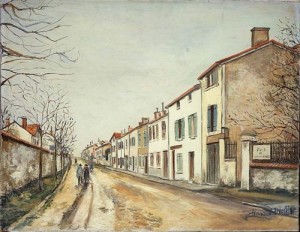Born: September 23, 1865 in Bessenes France, died: April 19, 1938 in Paris
A photograph of the artist
Much like the last artist I discussed, Edmonia Lewis, Suzanne Valadon was not born into ideal circumstances. Her mother was a laundress and raised her single-handedly with minimal wages, prompting Valadon to begin working at a young age. Throughout her childhood and adolescence she held many jobs in Montmartre, “the bohemian quarter of Paris“; she was a waitress, vegetable seller, nanny, and perhaps most notably an acrobat. The independent teenager found herself working at a circus as a trapeze artist, a job that she loved dearly. Sadly, she injured her back when performing a routine and had to seek employment elsewhere in order to get by.
A young Valadon quickly found success in a field that wasn’t seen as the most respectable– she modeled for artists, who, as writer June Rose contends, “assumed the right to make love to their girls.” Valadon didn’t oppose this, and often maintained affairs with the painters, most notably Henri de Toulouse-Lautre. Her life consisted of more than posing and making love to famous men, as she began to foster her own interest in art at this time. She studied her employers, and with some encouragement from artist Edward Degas (who, as with Mary Cassatt, seems to be quite inspirational), she began to make art of her own in the early 1890s, exerting an impressive level of autonomy.
During this period, the burgeoning artist went through other major life changes. As an unmarried 18 year old, she gave birth to a baby boy. She was not entirely sure who was the father to the child, but Miguel Utrilo, an old lover, was convinced it was his. The responsibility of raising her infant son Maurice fell entirely on the shoulders of Valadon, who passed on the effort to her mother in order to focus on her career. Several years later she married a stockbroker, whose wealth provided her with the opportunity to spend all her efforts on painting.
Self Portrait, 1883
This is one of the earliest paintings by Valadon. It’s style is minimal and the subject matter tame– two characteristics that were found much less frequently in her later pieces
Consistent to the turbulent nature of Valadon’s romantic affairs, she was divorced in 1909. Around this time, she began focusing on what would become the trademarks of her style, painting nude figures and portraits in distinct marks and colors. Her pieces conveyed “an intensity of feeling and depth in her subjects with bold, heavy strokes,” which did not go unnoticed by the public. In 1911 she held her first solo exhibition, sparking her movement toward international fame.
Valadon’s home life was largely tumultuous. Her son began exhibiting signs of mental problems and alcoholism as a teenager, so she devoted much of her time caring for him. She greatly encouraged him to try painting, which apparently was effective, as he soon became a successful artist in his own right. Around the time of her divorce, Valadon also began a relationship with Andre Utter, an artist over twenty years her junior.
Adam & Eve, 1909
This painting depicts Valadon and Utter in the Biblical account of the first man and woman. It’s interesting to note that Valadon chose to depict Eve at the moment she picked the sinful fruit from the tree, perhaps alluding to the forbidden nature of her affair with Utter. This painting was also the first piece to be exhibited by a woman featuring a naked male and female, and is fascinating in its use of color and emotion in the couple’s forms.
When World War I broke out in Europe, Utter, now Valadon’s husband, enlisted to fight. When he returned from war, he lived with his wife and her artist son, Maurice, as the trio attempted to sell their pieces. Despite Valadon’s critical acclaim for her work, Maurice’s work caught the eye of the public, and he was able to profit nicely from his work. Valadon continued and exhibiting throughout this period and found success even though her son proved too be more lucrative.
Maurice Utrillo, 1921 by Valadon Suburban Street Scene, Utrilo
Clearly the focus and style of the paintings differ greatly, as Suzanne’s work was more novel while her son opted to create classic, subdued cityscapes.
Sadly, Valadon and her husband began to drift apart as he began having affairs with various women. Valadon’s health began declining in 1920, and it seems that around this point she began painting fewer nudes and focused instead on still-lives. She continued to work persistently, even up to the day of her death in 1938, when she suffered a stroke.
Nonetheless, Valadon was a fascinating woman, whose pieces simply can’t go unappreciated, even though for a period of time her son’s work garnered more attention. I feel as though she lived during a period when the notion of the nonconformist, whimsical artist really came into fruition. They became almost the rock stars of early 20th century Europe and America, and she certainly fed into that stereotype, with her numerous affairs and disregard for what was considered appropriate in a painting. She transformed from a model, a mere pretty object for an artist to depict, to a creator in her own right, and I find that immensely empowering.
Reclining nude, 1928
URLS:
http://nmwa.org/explore/artist-profiles/suzanne-valadon
http://www.britannica.com/biography/Suzanne-Valadon
http://www.notablebiographies.com/supp/Supplement-Sp-Z/Valadon-Suzanne.html






